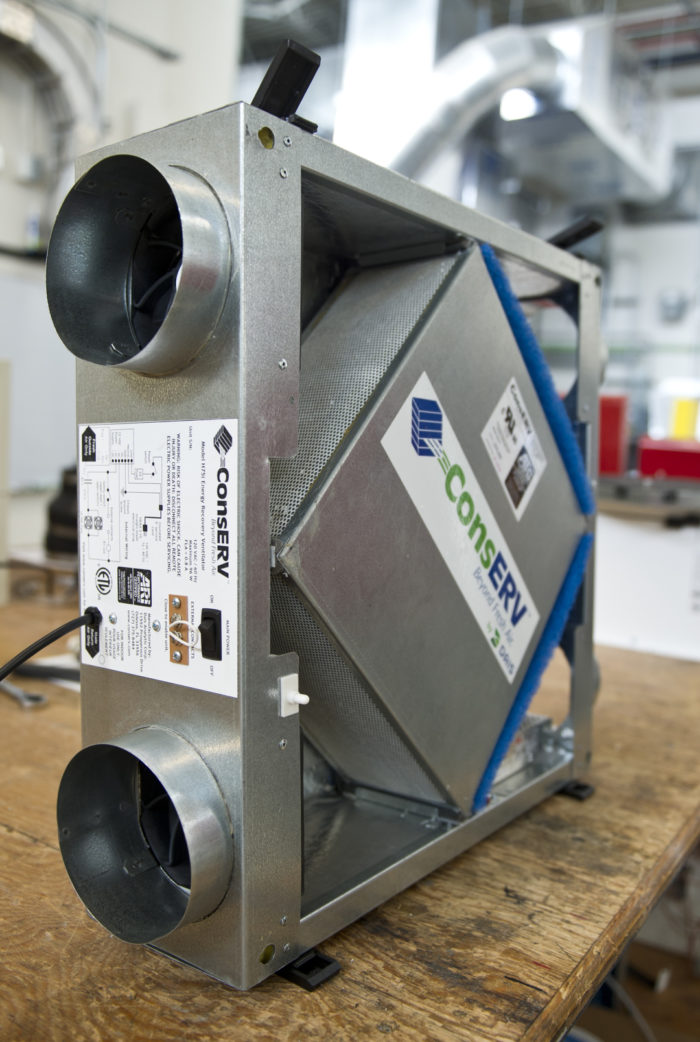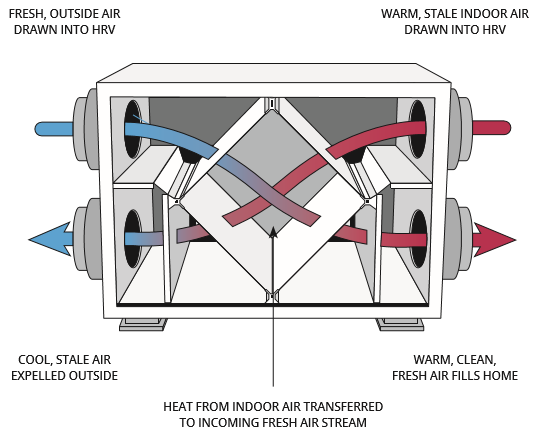How to Save Money with HRV in Variable Seasons
Wiki Article
Introducing the Trick Benefits and Uses of Heat Recovery Ventilation in Sustainable Design
Heat Recovery Ventilation (HRV) systems play an important function in sustainable layout. They help with a constant exchange of stagnant indoor air with fresh outdoor air, greatly enhancing indoor air quality. HRVs add to power effectiveness by redeeming warm from tired air, which can reduce energy costs. Understanding the diverse advantages and applications of HRVs reveals their relevance in contemporary style. What other advantages do these systems provide in the search of sustainability?Understanding Heat Recovery Ventilation Systems
Heat recovery ventilation (HRV) systems are created to boost interior air quality while lessening power loss. These systems make use of a mechanical ventilation strategy to exchange stagnant indoor air with fresh outdoor air, making sure a constant supply of tidy air. By catching warmth from the exhaust air, HRVs precondition incoming air, minimizing the demand on heating and cooling down systems. This process not only improves thermal comfort yet also adds to power efficiency in property and business structures. Additionally, HRV systems assist manage moisture degrees and reduce indoor contaminants, advertising a much healthier living setting. Their strategic application is important for attaining lasting style objectives, as they supply an equilibrium between power preservation and occupant wellness.How HRV Systems Work
While numerous may recognize with air flow systems, recognizing just how heat recovery air flow (HRV) systems run is vital for valuing their advantages. HRV systems operate by trading stagnant indoor air with fresh outside air while transferring heat in between both streams. This procedure takes place in a warmth exchanger, where warm from the outward bound air heats the incoming air throughout chillier months, lessening energy loss. On the other hand, in warmer months, the system can cool down incoming air utilizing the cooler outgoing air. HRVs are outfitted with fans to promote airflow and filters to get rid of particulates, making sure a continual, balanced ventilation procedure. This innovative style not only enhances power effectiveness but also adds to keeping a comfortable interior atmosphere.Enhancing Indoor Air Top Quality
Indoor air quality can considerably impact wellness and health, making efficient air flow necessary in modern homes. Heat Recovery Ventilation (HRV) systems play an essential duty in maintaining indoor air top quality by continuously trading stagnant indoor air with fresh exterior air. This procedure not just lowers air-borne pollutants however also lessens humidity degrees, which can result in mold development and breathing issues. HRV systems filter incoming air, eliminating irritants and particulates, consequently supplying a much healthier living environment. In addition, these systems help remove smells and unstable natural compounds (VOCs) generally found in family items. By making sure a consistent circulation of clean air, HRV systems add to a total improved indoor ambience, promoting comfort and wellness for owners.Energy Effectiveness and Price Savings
Energy effectiveness attracts attention as a substantial benefit of Heat Recovery Ventilation (HRV) systems. By capturing and reusing the warm from tired interior air, HRVs reduce the power needed for heating incoming fresh air, causing minimized power usage. This effectiveness equates right into lower utility bills, providing substantial cost savings for homeowners and companies alike. Furthermore, HRV systems commonly receive power performance motivations and discounts, further improving their economic charm. In time, the initial investment in HRV innovation can result in a favorable return on investment via decreased energy expenditures. The assimilation of HRV systems not just promotes lasting layout yet additionally gives a functional service for achieving lasting power cost savings and financial advantages.Ecological Benefits of HRV

A wide range of environmental advantages develops from the application of Heat Recovery Ventilation (HRV) systems. By effectively transferring heat from exhaust air to incoming fresh air, HRVs significantly lower the energy required for heating and cooling spaces. This power performance converts to lower greenhouse gas emissions, adding to a reduction in the general carbon footprint of structures. Furthermore, HRV systems improve indoor air high quality by continuously flowing fresh air, consequently decreasing the focus of interior pollutants and irritants. Additionally, the reduction in power usage help in saving natural deposits, making HRVs a vital part of lasting style. In general, the ecological benefits of HRVs play a crucial role in advertising a much healthier earth and fostering eco-friendly building techniques.
Versatile Applications in Modern Architecture
Heat recovery ventilation (HRV) systems are progressively being integrated into both residential and commercial building projects. In residential settings, HRVs boost interior air top quality while making best use of energy effectiveness. In business rooms, these systems maximize ventilation strategies, demonstrating their adaptability in modern-day architectural applications.Residential Projects Combination
While modern-day style increasingly emphasizes sustainability, the integration of heat recuperation ventilation systems in residential projects has become a sensible solution for enhancing interior air quality and energy efficiency. These systems successfully move warm from exhaust air to inbound fresh air, decreasing power loss and reducing heating or cooling down demands. In new builds and retrofits alike, warm recuperation ventilation can be effortlessly included, supplying home owners with a much healthier living atmosphere while reducing utility expenses. Additionally, with enhancing awareness of environmental impacts, more architects and contractors are recognizing the long-term advantages of these systems. Consequently, warm healing ventilation has actually come to be a crucial element of lasting domestic design, showcasing flexibility and commitment to eco-friendly techniques.Industrial Areas Optimization
As modern business spaces progress to fulfill the needs of sustainability and efficiency, the application of heat recovery air flow systems becomes a vital approach for optimizing interior settings. These systems assist in the exchange view website of stagnant interior air with fresh outdoor air while redeeming heat, considerably lowering energy intake. This not only improves convenience for residents yet likewise aids in reducing functional expenses. Functional applications can be observed in workplaces, retail spaces, and universities, where air quality and temperature level control are critical. Additionally, incorporating warmth recuperation ventilation aligns with green structure certifications, further advertising environmental obligation. Eventually, taking on such systems in commercial design not just adds to sustainability goals however additionally promotes much healthier, more efficient areas for individuals.
Incorporating HRV Into Sustainable Layout Practices
Integrating warmth recuperation air flow (HRV) systems right into lasting layout techniques uses substantial advantages in power performance and interior air high quality. By using HRV, designers can create affordable services that not only minimize power usage however likewise enhance the overall convenience of interior settings. This positioning with sustainability goals positions HRV as a vital element in modern-day building approaches.
Energy Performance Enhancement
By integrating warm recovery air flow (HRV) systems right into sustainable design practices, engineers and builders can significantly enhance power effectiveness in modern constructions. HRV systems operate by catching heat from outbound stale air and moving it to incoming fresh air, minimizing the power needed for heating or cooling down indoor rooms. This process not just reduces dependence on conventional HVAC systems however also reduces overall power usage. Additionally, HRV systems can assist keep a consistent indoor temperature level, decreasing peak power demands. By integrating these systems, structures can accomplish substantial reductions in utility expenses and carbon impacts, lining up with sustainability objectives. Ultimately, HRV innovation represents a functional service for enhancing energy performance in the built environment, advertising more accountable resource usage.Indoor Air Top Quality Improvement
Exactly how can heat recovery ventilation (HRV) systems add to exceptional indoor air high quality in modern buildings? HRV systems effectively exchange stagnant indoor air with fresh outdoor air while recuperating heat, reducing temperature level variations. This process decreases the focus of interior toxins, such as volatile organic compounds (VOCs), allergens, and dampness, which can wear away air quality and impact resident health and wellness. By preserving ideal humidity levels and making useful source sure a continual supply of tidy air, HRVs aid produce a much healthier interior setting. Additionally, these systems can be incorporated into sustainable design methods, promoting energy performance along with improved air high quality. HRV Heat Recovery Ventilation. Consequently, HRV innovation plays an essential function in advancing overall passenger comfort and wellness in contemporary architectural layoutsAffordable Design Solutions

Regularly Asked Concerns
What Maintenance Is Needed for Heat Recovery Ventilation Equipments?

Maintenance for warmth recovery air flow systems typically includes regular filter substitutes, cleansing of heat exchangers, examination of fans and air ducts, and ensuring correct drain. These jobs help preserve performance and prolong the system's life expectancy over time.
Can HRV Solutions Be Mounted in Existing Structures?
Heat recovery ventilation systems can certainly be set up in existing structures. HRV Heat Recovery Ventilation. Retrofitting requires cautious planning and analysis of the structure's layout, guaranteeing compatibility with existing systems while making best use of power efficiency and interior air high qualityHow Do HRV Systems Effect Sound Levels Indoors?
HRV systems can influence interior sound degrees by presenting audio from external sources through ventilation. Premium setups commonly integrate sound-dampening functions, lessening sound effect while supplying reliable air exchange and maintaining convenience inside.Exist Any Type Of Drawbacks to Utilizing HRV Systems?
The downsides of making use of HRV systems consist of possible high preliminary costs, upkeep obstacles, and the opportunity of minimized interior air high quality if filters are sporadically transformed, which could cause concerns with humidity degrees.Exactly how Do I Choose the Right HRV System for My Requirements?
Selecting the best heat recuperation ventilation system involves evaluating specific needs, such as developing size, climate, and power efficiency objectives. my response In addition, assessing system functions, installation needs, and maintenance factors to consider is crucial for peak efficiency and complete satisfaction.Report this wiki page